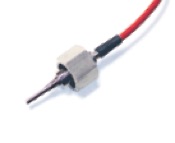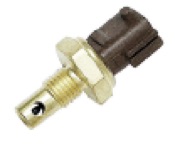 |
| Sensors used in HVAC |
Reprinted with permission from Gems Sensors & Controls white paper.
 |
| RTD |
Assuming equivalent thermistor quality and resistance values, combining the thermistor within a housing that can be installed into HVAC or chiller equipment is what differentiates one sensor assembly from another. These fall into two basic types: exposed or enclosed thermistor housings.
 |
| Open sensor thermistor probe. |
Enclosed thermistors encase the thermistor inside a probe that is an integral part of the housing. These eliminate the leakage issue, but because the thermistor is actually in an air pocket surrounded by the metal or plastic housing, temperature compensation and sensor responsiveness issues are introduced.
 A Recent Third Option
A Recent Third Option Gems Sensors & Controls has produced a third type of housing that combines the performance of an exposed thermistor design, while providing the hermetic sealing of an enclosed sensor housing. Known as the TM-950 Series, these thermistor-based temperature sensors were designed specifically to solve long-term reliability issues in HVAC and Chiller applications.
TM-950 Series temperature sensor incorporates a unique fused-glass technique to produce a hermetically sealed the housing. Molten glass is placed inside the heated housing. As the assembly cools the metal housing shrinks, compressing the glass. In addition, the boundary surface of heated metal and glass bond at a molecular level. Two nickel-plated steel tubes are positioned pre-positioned before the glass fusing process to provide a pass through for the thermistor leads. Any of a variety of thermistors may be utilized based on the temperature sensing profile required. Once leads are passed through the steel tubes and glass, induction soldering fills the tubes completely, providing a leak-proof seal to 450 psig. The result is a sensor with the benefits of direct fluid contact incorporating the leak-proof attributes of an enclosed sensor.
For more information on selecting sensors for industrial HVAC applications and chillers visit Swansonflo.com or call 800-288-7926






